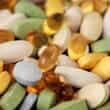Background
- Molybdenum is a transition metal, and it is required by most organisms, including humans. Molybdenum is found in the earth's crust, soil, and plants, and higher levels are found in the soil of certain areas, such as Australia and New Zealand. In plants, molybdenum is found in higher concentrations in those having symbiotic relationships with nitrogen-fixing bacteria, such as legumes and leafy vegetables. Molybdenum is also found in animal livers and dairy products. Recommended dietary allowances, tolerable upper intake levels, and adequate intake levels have been established for molybdenum for children, adults, and pregnant or lactating women.
- In the human body, molybdenum is considered an essential trace element and plays an important role as a cofactor for several enzymes. Molybdenum deficiency results in decreased activity of these enzymes. Molybdenum and related compounds (thiomolybdate products) have been studied for use in cancer, macular degeneration, cataract prevention, cirrhosis (scarring of the liver), symptomatic Wilson's disease (an inherited disorder resulting in too much copper), hypertension, and stroke. Further research is needed.
- Adverse effects associated with high doses of molybdenum include decreased copper levels in the body, decreased blood cell production, goutlike symptoms, and central nervous system effects. Also, molybdenum contamination of supplements, foods, and drugs may need to be monitored, due to the possibility of toxic effects at high levels.
References
Natural Standard developed the above evidence-based information based on a thorough systematic review of the available scientific articles. For comprehensive information about alternative and complementary therapies on the professional level, go to . Selected references are listed below.
- Askari F, Innis D, Dick RB, Hou G, Marrero J, Greenson J, Brewer GJ. Treatment of primary biliary cirrhosis with tetrathiomolybdate: results of a double-blind trial. Transl Res. 2010 Mar;155(3):123-30.
View Abstract - Blot WJ, Li JY, Taylor PR, Guo W, Dawsey S, Wang GQ, Yang CS, Zheng SF, Gail M, Li GY, et al. Nutrition intervention trials in Linxian, China: supplementation with specific vitamin/mineral combinations, cancer incidence, and disease-specific mortality in the general population. J Natl Cancer Inst. 1993 Sep 15;85(18):1483-92.
View Abstract - Brewer GJ, Johnson V, Dick RD, Kluin KJ, Fink JK, Brunberg JA. Treatment of Wilson disease with ammonium tetrathiomolybdate. II. Initial therapy in 33 neurologically affected patients and follow-up with zinc therapy. Arch Neurol. 1996 Oct;53(10):1017-25.
View Abstract - Brewer GJ, Dick RD, Grover DK, LeClaire V, Tseng M, Wicha M, Pienta K, Redman BG, Jahan T, Sondak VK, Strawderman M, LeCarpentier G, Merajver SD. Treatment of metastatic cancer with tetrathiomolybdate, an anticopper, antiangiogenic agent: Phase I study. Clin Cancer Res. 2000 Jan;6(1):1-10.
View Abstract - Brewer GJ, Hedera P, Kluin KJ, Carlson M, Askari F, Dick RB, Sitterly J, Fink JK. Treatment of Wilson disease with ammonium tetrathiomolybdate: III. Initial therapy in a total of 55 neurologically affected patients and follow-up with zinc therapy. Arch Neurol. 2003 Mar;60(3):379-85.
View Abstract - Brewer GJ, Askari F, Lorincz MT, Carlson M, Schilsky M, Kluin KJ, Hedera P, Moretti P, Fink JK, Tankanow R, Dick RB, Sitterly J. Treatment of Wilson disease with ammonium tetrathiomolybdate: IV. Comparison of tetrathiomolybdate and trientine in a double-blind study of treatment of the neurologic presentation of Wilson disease. Arch Neurol. 2006 Apr;63(4):521-7.
View Abstract - Coulter ID, Hardy ML, Morton SC, Hilton LG, Tu W, Valentine D, Shekelle PG. Antioxidants vitamin C and vitamin e for the prevention and treatment of cancer. J Gen Intern Med. 2006 Jul;21(7):735-44.
View Abstract - Henry NL, Dunn R, Merjaver S, Pan Q, Pienta KJ, Brewer G, Smith DC. Phase II trial of copper depletion with tetrathiomolybdate as an antiangiogenesis strategy in patients with hormone-refractory prostate cancer. Oncology. 2006;71(3-4):168-75.
View Abstract - Li B, Taylor PR, Li JY, Dawsey SM, Wang W, Tangrea JA, Liu BQ, Ershow AG, Zheng SF, Fraumeni JF Jr, et al. Linxian nutrition intervention trials. Design, methods, participant characteristics, and compliance. Ann Epidemiol. 1993 Nov;3(6):577-85.
View Abstract - Lowndes SA, Adams A, Timms A, Fisher N, Smythe J, Watt SM, Joel S, Donate F, Hayward C, Reich S, Middleton M, Mazar A, Harris AL. Phase I study of copper-binding agent ATN-224 in patients with advanced solid tumors. Clin Cancer Res. 2008 Nov 15;14(22):7526-34.
View Abstract - Meeker, J. D., Rossano, M. G., Protas, B., Diamond, M. P., Puscheck, E., Daly, D., Paneth, N., and Wirth, J. J. Cadmium, lead, and other metals in relation to semen quality: human evidence for molybdenum as a male reproductive toxicant. Environ.Health Perspect. 2008;116(11):1473-1479.
View Abstract - Pass HI, Brewer GJ, Dick R, Carbone M, Merajver S. A phase II trial of tetrathiomolybdate after surgery for malignant mesothelioma: final results. Ann Thorac Surg. 2008 Aug;86(2):383-9.
View Abstract - Redman BG, Esper P, Pan Q, Dunn RL, Hussain HK, Chenevert T, Brewer GJ, Merajver SD. Phase II trial of tetrathiomolybdate in patients with advanced kidney cancer. Clin Cancer Res. 2003 May;9(5):1666-72.
View Abstract - Sperduto RD, Hu TS, Milton RC, Zhao JL, Everett DF, Cheng QF, Blot WJ, Bing L, Taylor PR, Li JY, et al. The Linxian cataract studies. Two nutrition intervention trials. Arch Ophthalmol. 1993 Sep;111(9):1246-53.
View Abstract - Vine AK, Brewer GJ. Tetrathiomolybdate as an antiangiogenesis therapy for subfoveal choroidal neovascularization secondary to age-related macular degeneration. Trans Am Ophthalmol Soc. 2002;100:73-6; discussion 76-7.
View Abstract







